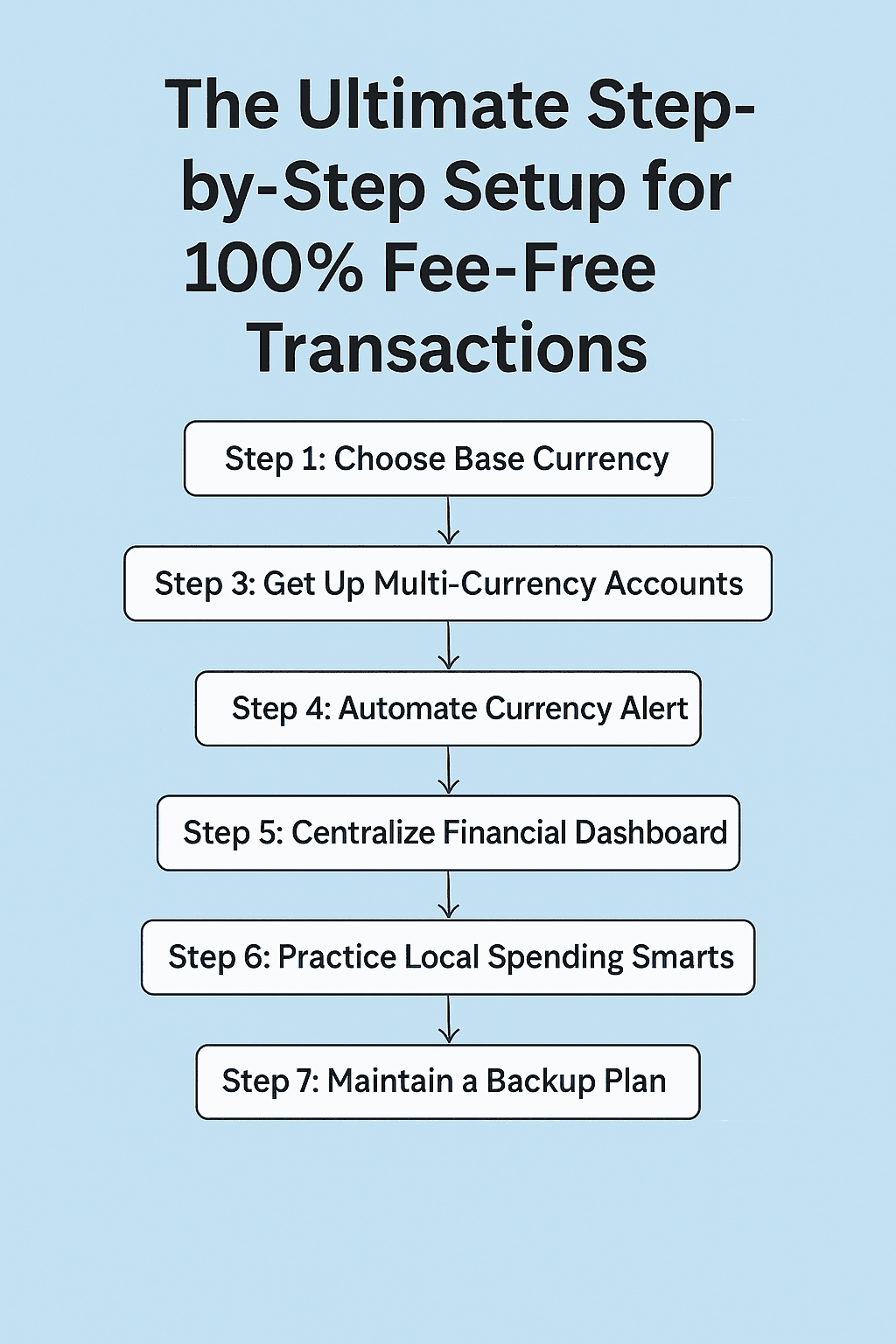By now, you’ve learned about hidden fees, the best fintech tools, and the top cards available in 2025. But knowing isn’t enough. If you want to actually achieve zero-fee global transactions, you need a clear, action-oriented setup.
This final part of the series lays out a step-by-step system you can implement today—whether you’re preparing for international travel, studying abroad, freelancing globally, or managing cross-border business. It’s practical, adaptable, and designed for real-world use.
Step 1: Choose Your Base Currency (and Account Country)
Start by identifying your primary source of income and your most frequently used spending currency.
Why this matters:
- Some cards perform better in specific currencies (USD, EUR, GBP)
- Your “home” currency affects exchange timing, fees, and compliance
- Regulatory access may depend on your country of residence
Action:
Open a Wise or Revolut account based on where you earn and spend most often. Choose one that offers local account details in the currencies you need.
Step 2: Set Up Multi-Currency Accounts
Avoid forced, automatic conversions. Instead, hold balances in multiple currencies and convert only when the rate is favorable.
Tools:
- Wise multi-currency account
- Revolut currency spaces
- Crypto-stablecoin wallet (optional, e.g., USDC)
Action:
Enable accounts in your most-used currencies. Keep a buffer in each to avoid urgent conversions during bad rates.
Step 3: Get the Right Cards (Physical and Virtual)
Use one card for ATM withdrawals, another for spending, and a virtual card for online purchases and security.
Recommended Setup:
- Charles Schwab debit card → Fee-free cash withdrawals (U.S. users)
- Revolut or Wise card → Real-time currency conversion for daily purchases
- Virtual card (from Wise or Revolut) → Safe online shopping or travel bookings
Action:
Order both physical and virtual cards. Link them to the appropriate accounts.
Step 4: Automate Currency Alerts and Transfers
Let technology work for you. Use automation to convert currencies only when favorable.
Tools:
- Revolut exchange alerts
- Wise rate notification + auto-convert
- Google Finance widgets for monitoring
Action:
Set alerts at your target exchange rate. Automate conversions with limits to avoid emotional decisions.
Step 5: Centralize Your Financial Dashboard
Stop jumping between apps. Use a centralized tool to see all your balances, transactions, and rates.
Options:
- Revolut’s built-in dashboard
- Budgeting apps like YNAB or Monarch
- Spreadsheet synced via Wise/Revolut exports
Action:
Build or install a personal finance dashboard that shows everything at a glance—cards, accounts, currencies, fees.
Step 6: Practice Local Spending Smarts
Even with the best tools, poor in-person decisions can waste money.
Rules to remember:
- Always pay in local currency, not your home currency
- Avoid Dynamic Currency Conversion (DCC) at all costs
- Don’t withdraw small cash amounts repeatedly—withdraw strategically
- Ask: “Does this card charge me for foreign use?” before traveling
Action:
Build habits: check settings, receipts, and ATM options every time.
Step 7: Maintain a Backup Plan
Cards can be lost. Apps can crash. Travel plans change. Always prepare a secondary method.
Your safety net:
- A secondary card with emergency funds (Capital One or backup Revolut)
- A small amount of physical cash in USD or EUR
- Screenshots of key account numbers or card info (securely stored)
Action:
Keep your backup setup somewhere accessible but safe. Review it monthly.
Sample Setup for Different User Types
| User Type | Recommended Setup |
|---|---|
| Digital Nomad | Wise + Revolut (Premium) + virtual card + crypto wallet |
| International Student | Wise multi-currency + physical & virtual card + budget app |
| Retiree Abroad | Charles Schwab card + Wise account + minimal app use |
| Freelancer | Wise Business + Revolut + dashboard for invoicing & conversion |
| Business Owner | Wise Business + Revolut Business + automated workflows |
Final Checklist: Your 100% Fee-Free Toolkit
- Multi-currency account (Wise or Revolut)
- Physical and virtual cards (at least 2)
- Currency alerts set and working
- Backup funds and method secured
- Real-time financial dashboard
- Healthy spending habits developed
Conclusion
Zero-fee global transactions are not a fantasy. They are absolutely achievable with the right tools, habits, and setup.
This isn’t just about saving a few dollars—it’s about taking complete control of your money across borders, platforms, and currencies.
If you’ve read all seven parts of this series, you’re now ahead of 99% of global consumers.
Now take the final step: implement it. Your global wallet is waiting.
